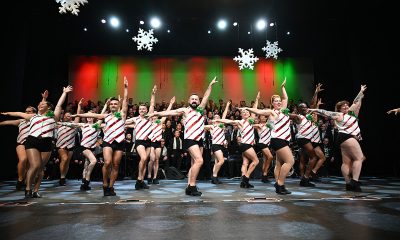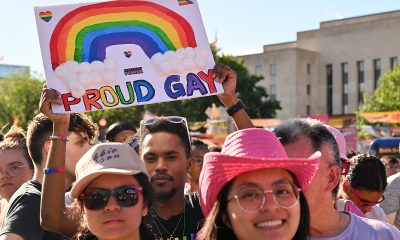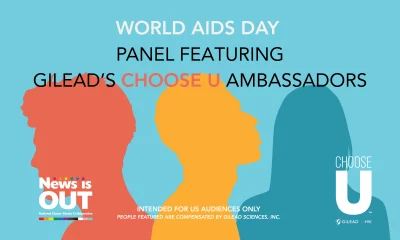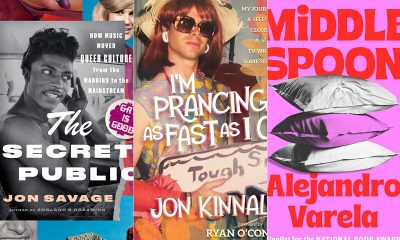a&e features
The business of performing at Pride
Show me the money: Crowds expect big names but most events are non-profits
Icona Pop perform at the 2013 Capital Pride Festival. (Washington Blade file photo by Tyler Grigsby)
When asked why she made Pittsburgh the site of her first Pride appearance in 2012 as opposed to a trendier city, out rocker Melissa Etheridge was matter of fact: “Pittsburgh showed me the money,” she told the crowd to a huge round of applause.
In retrospect, though, it wasn’t the stretch it might have seemed at first glance. Despite her industry cred as a Grammy-winning soul rocker with enough pop sensibility to have secured an impressive run of radio hits in the ‘90s, Etheridge has always projected a rootsy, blue-collar vibe much the same way Bruce Springsteen and John Mellencamp have straddled the heartland/A-lister fence for decades on end. And yet, for Pittsburgh Pride, it was a huge moment.
“She really was up there just preaching and having fun,” says Gary Van Horn, president of the board of the Delta Foundation of Pittsburgh, the agency that produces Pittsburgh Pride. “She used the pulpit and she was speaking to her people.”
Van Horn says Etheridge was contracted to do a 75-minute set but ended up playing for about two-and-a-half hours. And although details of her contract are protected, as is the industry norm, by a confidentiality clause, Van Horn says he didn’t find her fee outrageous considering she travels with 11 people counting band members and manager, whose travel and hotel expenses have to be paid. After deciding in 2006 to move Pittsburgh Pride downtown and have a big-name headliner give a full concert-length set for which patrons would have to purchase tickets, Van Horn says he and his team couldn’t have been more pleased with Etheridge’s set.
“At the end of the day, I would be very, very shocked if she cleared more than thousands of dollars just knowing she had to pay everybody,” he says. “There is a thought process out there that they should be doing this for free since it’s a non-profit Pride event, but this is their job. This is how they pay their bills, they go and perform. Obviously it’s important to do charity work sometimes, but there are over 120 Pride events in the U.S. that I know of and we’re only talking about a handful of artists that are even remotely available to that group and the same handful of folks at every Pride organization wants them, so to just expect them to do it for free is just not feasible. We showed her the money because she needed to have that.”
The behind-the-scenes business of bringing celebrity entertainers in to perform at Pride events — historically seen as a stage for either up-and-comers or past-their-prime acts that haven’t had hits in years but to whom gay men have been traditionally loyal — is a dicey discussion. Obviously everybody wants to dream big and hope for a legend, but there are many factors involved: tour schedules, riders, appearance fees, whether the show is free or requires a ticket and more. Because the Capital Pride Festival is a free event, few would expect somebody of Beyonce’s caliber would be willing to give a free two-hour show. That hasn’t, however, stopped organizers — many of whom, like Van Horn, are volunteers — from exploring how many branches up the higher-hanging fruit sits.
“Of course I would always aim high and then get shot back down,” says Steve Henderson, a Capital Pride volunteer who worked for 17 years (his last year was 2013) on the entertainment planning committee. “Unless they were going for a pro bono show, we would never be able to get a Gaga, Britney or Madonna-like act. Not while it’s a free festival. Gaga is a minimum $1 million plus more riders than Pride could ever handle. She also required a 10-truck load in and performance rehearsals weeks in advance, which we cannot do since the stage is installed the evening of the festival. That has been the problem with the ‘A grade’ headliners.”
Henderson says he worked for years on a shoestring budget of about $15,000-20,000 at most for the day, a figure that had to include traveling expenses, lodging and everything. As you might imagine, most of the entertainers who play throughout the day on the Capital Pride main stage — the Gay Men’s Chorus, the drag cast at Ziegfeld’s, emcees such as Destiny Childs, etc. — donate their time. Corporate sponsorships and partnerships have given current organizers bigger budgets, he says. Ryan Bos, Capital Pride executive director, says he’s not allowed to disclose the budget for headliners.
Despite the challenges, Henderson, who now lives in Chicago, has many good memories and says he’s proud of the many acts they brought in over the years — RuPaul in 2009, Chely Wright in 2010, Deborah Cox in 2012 and Cher Lloyd, Emeli Sande and Icona Pop in 2013 and more.
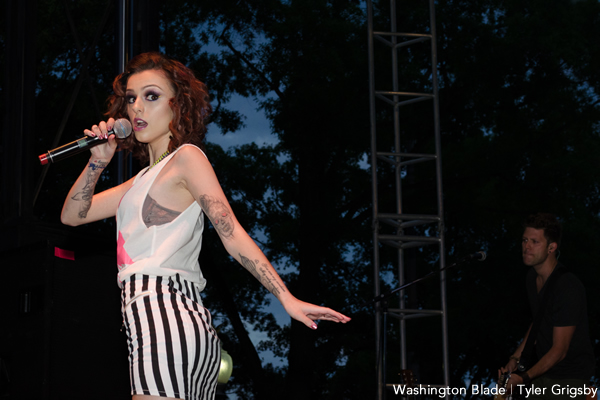
Cher Lloyd performs at the 2013 Capital Pride Festival. (Washington Blade file photo by Tyler Grigsby)
He says only two acts ever cancelled — Mya gave about three weeks’ notice citing a skiing accident in 2010. Chely Wright had just come out and was happy to fill in. The biggest nail biter, Henderson says, was Kelly Rowland’s 2011 cancellation about a week before the event. His years of working as a DJ with various record labels was always a help, but especially then, he says. Broadway belter Jennifer Holliday, who’d just sung with the Gay Men’s Chorus of Washington the week before, saved the day.
“I didn’t really have time to freak out, I just had to figure out who we were gonna get,” Henderson says. “Thankfully I knew Jennifer from past work and I literally called her within a minute of it happening. She was somebody we had discussed about being a headliner or a co-headliner but we didn’t have the budget to do both. We had landed Kelly, which was pretty huge since her song was so big at the time, we really felt we had a winner.”
Henderson says her camp gave no reason for the abrupt cancellation.
“It was just a real quick e-mail. ‘Sorry, not-gonna-be-able-to-make-it’-type thing. No reason.”
Bos says three years ago the team that now plans main stage entertainment opted for a different approach and now bring in three co-headliners who each perform 25-35-minute sets to give the event more of a festival concert-type feel.
“We did it to diversify, to set ourselves apart a little and to not throw all the eggs in one basket,” he says.
This year’s concert, co-presented with radio station Hot 99.5, will feature En Vogue, Wilson Phillips, Amber and Carly Rae Jepsen. He says ‘90s acts like the former two were purposefully chosen to dovetail with this year’s Flashback theme as it’s the 40th anniversary of Capital Pride. Last year’s lineup was Karmin, Bonnie McKee, DJ Cassidy and Betty Who.
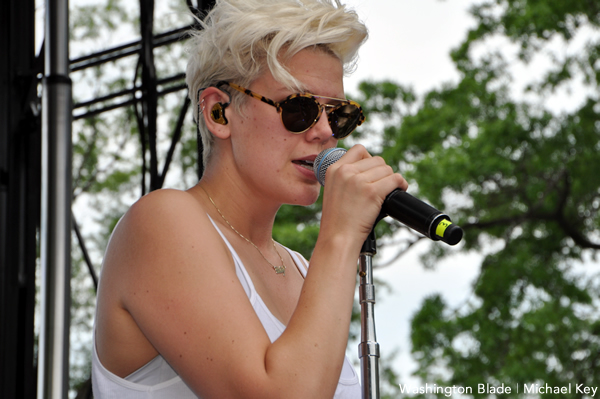
Betty Who performs at the 2014 Capital Pride Festival. (Washington Blade file photo by Michael Key)
And while there will always be a spot for yesterday’s hit makers at various Pride events — one recalls Inaya Day (“Nasty Girl”) who played Capital Pride in 2010 or Taylor Dayne (“Tell it to My Heart”) who’s found new life headlining Prides all over the Eastern Seaboard — Bos says the notion that Pride is a place for washed-up divas of yesteryear is an anachronism.
“I think that’s an old perception,” he says. “For artists who are trying to launch an album, Pride provides an opportunity to get in front of a huge community. For those who have been around a while, they know the support from the gay community so they see it as a way to give back, but that perception has been shifting for a while now and you see it at other Prides as well.”
Michael Musto, gay author and Musto! the Musical! columnist at out.com, agrees.
“It used to be unfairly thought of as a dubious career move to do Pride-related events, but as LGBT became more accepted, so did Pride,” he told the Blade. “Once big names started performing at the Pier dance after the parade here in New York City (for big money of course), there was no stigma at all. They can also work the parade itself or do any number of things around the country for Pride and it’s considered a good move for all involved.”
Van Horn says the caliber of talent at Pittsburgh Pride started an uptick after they brought in Tiffany in 2006 and Kimberley Locke in 2007. In recent years, besides Etheridge, they’ve brought in top acts like Adam Lambert and Patti LaBelle. This year’s headliner is Iggy Azalea.
He says overall the community understands and established acts like Etheridge and LaBelle bring in their own fan bases, people who ordinarily wouldn’t attend Pride.
“Of course, yeah, everybody wants Cher or Cyndi Lauper or J. Lo or Beyonce but they have to be realistic,” Van Horn says. “They’re in high demand and they get paid a lot. We have a list that continually gets updated via committee and we get suggestions from the community and then we start putting feelers out there with agents and management companies.”
He also says there are a bounty of expenses involved in bringing in household names that the general public would never think of such as the logistics of building a downtown stage for a one-off, lights, power, security, portable toilets, fencing, clean-up services — all in addition to the event itself. The Delta Foundation has one paid staff member and a host of volunteers.
“You’re a victim of your own success in a way,” he says. “You continue to attract more and more people and yet it’s also up to you to make sure they’re all safe and provided for as well. Our Sunday event attracts about 90,000 people so you have to make sure they’re all safe, have food to eat and drink throughout the day, the tents, tables and chairs — you have to provide all that.”
So what’s it like from the other side? Are there any unwritten industry rules for playing Pride events among artists and managers?
Howard Bragman, a gay PR veteran of Fifteen Minutes who’s worked with many LGBT acts, says not really. Several acts in his stable will be at various Prides this year including Chaz Bono who will appear at Toronto Pride with Lauper and Pussy Riot, and Ty Herndon who’s slated for Chicago Pride.
“I think it depends on the person and the moment,” Bragman says. “Somebody ends up in the news and comes out and suddenly all the Prides come after you. It’s a great honor. Even when they have to say no, it’s a great honor because you’re representing a community. … Nobody is offended. It’s a totally flattering moment.”
He says in New York and Los Angeles, where celebrities often live, it’s not uncommon for them to donate their time but if travel is involved, most Pride organizers know they’ll have to pay.
“It just depends,” he says. “But inevitably, yeah, it’s a family rate, it’s not their top-dollar corporate rate and for these people who have speaking engagements, generally it’s not just come in and ride in the parade for two hours. You come in the Friday before, there’s a reception, there are many interviews, sometimes on Saturday you cut the ribbon at the festival and then there’s the parade on Sunday. It’s a lot of work, but the best ones are the ones that are well organized and have been doing it a long time. Those are the ones they’re the happiest to do.”
Van Horn says it’s practically impossible to gauge how close Pride fees jell with rates the same artist would require for a regular appearance. Pride sets are typically much shorter than a normal show.
“There isn’t much data available on how much people pay for an artist because it’s all confidential,” he says. “Like at New York City Pride when Cher came out and sang four songs (in 2013), I know what Cher gets paid and I know New York City Pride wasn’t paying her typical fee.”
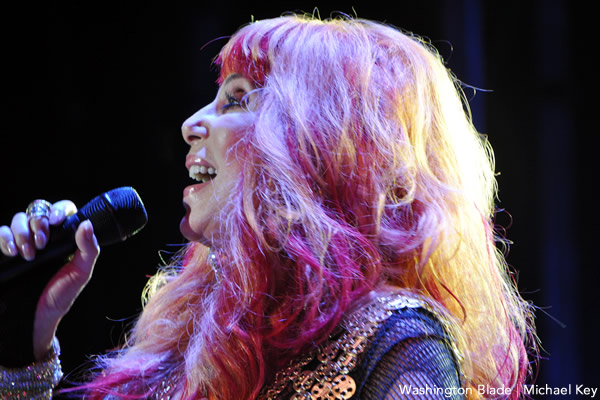
Cher performs at New York Pride’s ‘Dance on the Pier’ in 2013. (Washington Blade file photo by Michael Key)
Out singer-songwriter Eric Himan has played many Pride events since his first in South Florida in 2002. Now based in Tulsa, Okla., happily married and promoting his new album “Playing Cards,” he says Pride events have changed radically over the last decade or so.
“The thing about Pride is that Pride means something different to everybody and so every organizer has a different approach,” he says. “For some, it’s a rally. For others, it’s a day to get away from politics and just enjoy being out. The trajectory of how much Pride has changed from being something in the park that only gay people go to, to moving downtown and incorporating a lot of businesses and corporate sponsorships so it’s not just the gay bars sponsoring it, I’ve definitely noticed that change. So when you go in, you have to find out from the organizer what their idea of Pride is. I always viewed it as an opportunity to go be in my community and voice my ideas and concerns about how gay people fit into the world however you might go and everybody just wants a big dance party so you have to think about how you’re going to fit into that as the acoustic, live musician.”
He says there have been times the mid-tier musicians get shafted when various Pride committees spend the bulk of their budget to bring in a name act.
“Sometimes I’m glad to donate things, like CDs for a raffle or something like that,” he says. “My only concern is when I find out, ‘Oh hey, we just spent 80 grand on yada yada but will you play for free?,’ that’s kind of when I’m like, ‘That doesn’t seem correct.’ … When you go spend all your money on one person you wanted to bring, that’s when I get nervous about being a part of it.”
Playing for the exposure is a common bone some organizers toss, he says.
“Sometimes that’s OK but exposure is something you can’t really promise. What if it gets rained out that day? Well, there goes your exposure. Or what if the main act is at 12 that night, but they stick you on a stage next to it at 11 a.m.? Early on when you’re starting out as a musician, you don’t play for much money so the exposure works, but I’ve always found the times I’ve really gotten the best exposure have always been at paid gigs. I can’t recall one gig where they promised exposure and it was like, ‘Oh god, it worked out.’”

Eric Himan performs at the Capital Pride Festival in 2013. (Washington Blade file photo by Michael Key)
Henderson gets that but says over his 17-year tenure at Capital Pride, he guesses 70-80 percent of the acts, especially the community groups, donated their time.
“I had long-running relationships with a lot of these labels, so I was able to negotiate a lot of pro bono stuff,” he says. “Icona Pop was pro bono. So was Consuelo Costin and obviously all the local people like the Gay Men’s Chorus, the D.C. Cowboys and all the local favorites. They all came in to donate their time and production and give up half of their afternoon on a steaming hot Sunday.”
He also says the role of the Pride entertainment committee volunteer chair is a thankless job. He got involved as a “way to give back” but says it can easily ramp up into a second full-time job in the months leading up to Pride. He also says working by committee has a downside as well.
“We lost out on some really big ones over the years waiting for the board to make a decision,” Henderson says. “I wasn’t the one making the final decision and a couple times they waited too long and we lost out. Foster the People, Imagine Dragons and Diana Ross to name a few.”
Van Horn says all the artists he’s worked with have been easy and he has “no horror stories.”
“They always have safety and security concerns but that’s understandable,” he says. “There are crazies in the world. But no, there have never been any requests for M&Ms but take out all the blue ones or anything like that.”
Henderson says the hardest part of the job was always keeping things running smoothly backstage where there are only three cooled dressing room/trailers. Making sure they’re clean and free for who needs them at any given time is tough, he says.
“There’s always something going on like (local drag legend) Ella (Fitzgerald) shows up early and there’s no dressing room ready so her whole face melts off in the 100-degree heat,” he says with a laugh. “Getting the headliners from the hotel to the backstage area to making sure they had a dressing room ready and clean especially when you have 40-50 entertainers throughout the day, those logistics were always the hardest part.”
But on the occasions where it worked, there were magical moments. Henderson says when Pepper MaShay sang the “Dive in the Pool” song from “Queer as Folk” at the 2012 event with its famous line “Let’s get soaking wet,” the fire department’s decision to spray the crowd was not planned.
“It was probably 105 degrees that day and they were there to have some water stations so people could cool off because it was just so hot,” he says. “Ironically they had put this big main hose on a ladder truck maybe about 10 minutes before Pepper went on so we ran over to the fire chief and said it would be kind of neat if you could spray the crowd when she sang that line. When it happened, everybody thought it was pre-planned but we just decided that minutes before. People were dancing and going crazy. It was fantastic.”
Bragman says he always encourages his celebrity clients to do Prides anytime they can and says the payoff isn’t always in dollars.
“Pride is always a big deal,” he says. “It’s really powerful. I always say go with the right attitude, go and have fun and you will be changed. You always go home with so much more than you gave, that’s just the nature of the beast. It’s such an emotional high.”
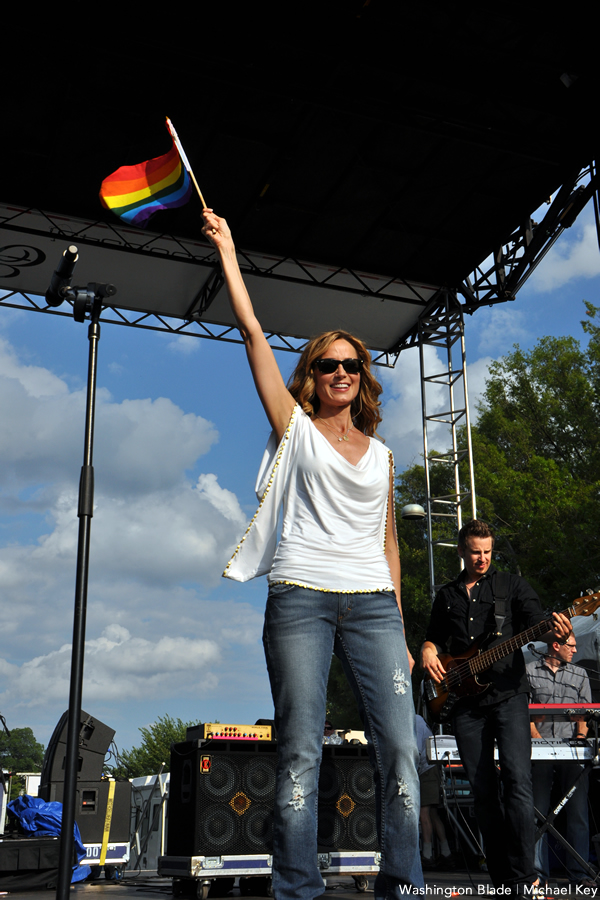
Chely Wright performs at the Capital Pride Festival in 2010. (Washington Blade file photo by Michael Key)
a&e features
Have yourself a merry John Waters Christmas
Annual holiday show returns to Alexandria and Baltimore
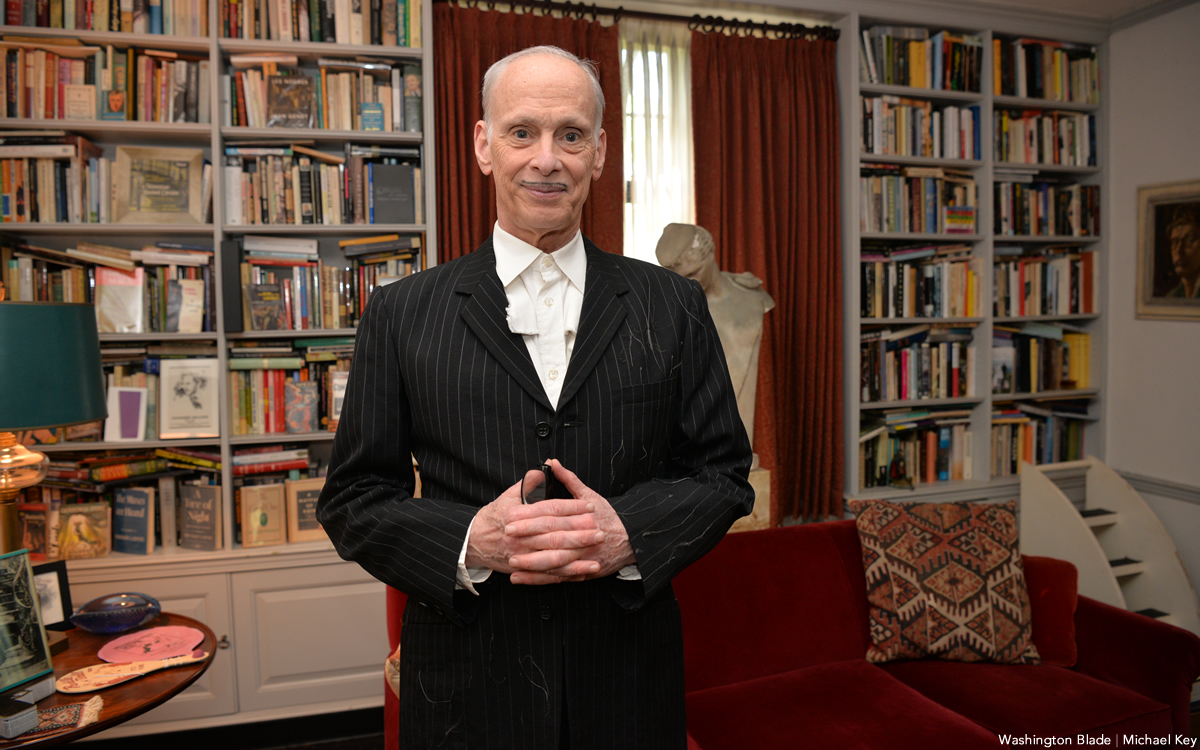
When it comes to iconic Christmas scenes in movies, none can top the tree-toppling tantrum thrown by cha-cha heels-deprived Dawn Davenport in John Waters’s fifth full-length feature “Female Trouble” from 1974. Therefore, it’s not surprising that Waters continues to make art out of Christmas, performing his spoken word Christmas tour in cities across the country. Waters has even more reason to celebrate with the release of his new red vinyl 7” single, a cover of Little Cindy’s “Happy Birthday Jesus (A Child’s Prayer)” on the A-side, and “A Pig Latin Visit From St. Nicholas” on the B-side. If you’re still looking for unique Christmas gifts, consider this record. As always, John was kind enough to make time for an interview in advance of his tour dates.
BLADE: John, in preparation for this interview with you, I went back and listened to Little Cindy’s original rendition of “Happy Birthday Jesus (A Child’s Prayer)” on your “A John Waters Christmas” CD.
JOHN WATERS: One thing I did, if you notice, I make the same stumble in my recording that she did in the original.
BLADE: It sounded to me like she got choked up.
WATERS: No, I think she just stumbles over a word, so I stumbled over the same word. It’s appropriation, insanely.
BLADE: Is this a song you first became aware of in your youth or when you were an adult?
WATERS: When I was doing the Christmas album, I had this friend named Larry Benicewicz. He was kind of my idea man with music. He knew every single old record. I would say to him, “Weird Christmas songs,” when we were doing a soundtrack, or a song about bears, or a song about this, and he would give me all these tapes. It was one of the ones he played for me. A lot of the songs I put in my movies and on my records, I did know as a kid. I did not know this one, but I immediately embraced it. I don’t think it’s campy. I think it really is spiritual in a weird way. My doing it makes it a novelty record. I am really for novelty records, and there aren’t any anymore. Why was there not a COVID novelty record? That’s insane. The dance “The Bug” that’s on the “Hairspray” soundtrack would be perfect for COVID.
BLADE: The thing that struck me was that for a Christmas song in the voice of a child, a kind of death pall hangs over it, with lines like, “If I was good you’d let me live with you” and “they nailed you to the cross, they wanted you to die.”
WATERS: All of it! When I see children at midnight mass kneeling in front of a nude man nailed to a cross, I feel like I’m at The Eagle! It is S&M, it’s creepy. I took the same cover (photo) from her record to parody and put my face on it. The same thing I did with The Singing Dogs last year when I covered (their version of) “Jingle Bells.” I’m really into novelty records. I love them and I’m trying to bring them back. I don’t expect anybody to ever play these records. Even The Singing Dogs one said on it, “Please do not play this record” [laughs]. And the flipside, the Pig Latin version, is almost impossible to listen to.
BLADE: I’m so glad you mentioned that. “A Pig Latin Visit From St. Nicholas” reminded me of the lost art of speaking in Pig Latin. I also recall watching the PBS series “Zoom” as an adolescent and learning to speak “ubbi dubbi,” a distant relative of Pig Latin. Do you think that the time is right for a Pig Latin or ubbi dubbi revival?
WATERS: Here’s the thing, I never could pick up any language, except Pig Latin. I’ve been in every foreign country. Foreign countries have given me money to learn to speak the language. I can never do it! But Pig Latin…my parents and other parents in the ‘50s spoke Pig Latin so kids couldn’t understand what they were saying. Then my mother taught it to me, and I used it. The hardest take to shoot in “Pink Flamingos” was not eating the dog shit. It was when the cast skipped, in one take, saying “E-way, are-yay e-they ilthiest-fay eople-pay in-hay e-they ole-hay ide-way orld-way.” We’re the filthiest people in the whole wide world in Pig Latin. We had to do so many takes so they could do it once without screwing it up. In “Polyester,” Edith (Massey) answers the phone, “ello-hay.” I did a photo piece where it was all subtitled in Pig Latin. Like “osebud-Ray” (from “Citizen Kane”) or in “Streetcar,” “ella-Stay!” [Laughs] All the iconic dialogue translated into Pig Latin. My assistant who helped me do it, had never heard of Pig Latin. She really got good at it because she lived in many foreign countries and can pick up languages. But it’s not that easy to do it correctly and read it. Your computer will translate into Pig Latin.
BLADE: AI understands Pig Latin?
WATERS: I guess that’s AI. It wasn’t 100% right, but it was close. I can speak it if I look at it, but just do a bit at a time. It was a challenge that no one would possibly care about or want to do.
BLADE: I think you pulled it off very well.
WATERS: If you want people to leave on Christmas morning, you put it on. That’s how you get your guests to leave. It’s time to go.
BLADE: Ood-gay i-bay! How did your relationship with record label Sub Pop, which released 2021, 2022, 2024, and new 2025 holiday singles, come about?
WATERS: I believe the first thing I did for them was “Prayer to Pasolini.” They came to me through Ian Brennan. He’s won a couple Grammys for World Music, but he is also is one of my agents who does the Christmas tour and a lot of my shows, anything with music. He helped me arrange each one of the songs. He had a relationship with Sub Pop. It was perfect. My friends in Baltimore, (the band) Beach House, have had huge success.
BLADE: That’s right, they’re on Sub Pop!
WATERS: Yes! I’m happy to be on it. I’ve even been to the warehouse and posed for pictures like Jackie Suzanne used to do.
BLADE: Is there any chance that “A John Waters Christmas” might be reissued on vinyl by Sub Pop?
WATERS: No. It’s such a nightmare to get the rights and to renew them. You have to find the publisher and the writer, and they usually hate each other. It doesn’t matter if it’s obscure or famous, it’s hard to get. You have to make the deal. The singer doesn’t get anything unless they play it on the radio. It would be so complicated legally, and there would be such a [laughs] tiny audience for it. I hope it will come out again. The same thing with the one for Valentine’s Day. I had two of them that did quite well when they came out; “A Date With John Waters and “A John Waters Christmas.” The “John Waters Christmas” album is still the soundtrack that plays whenever I’m doing my spoken word Christmas show as people are entering the theater.
BLADE: Aside from your annual Christmas show tour, what else do you do for the holidays now, and are there any traditions that you’ve carried over from your family?
WATERS: Certainly! I have two sisters, my brother’s widow, and me, so there are four and we take turns each year to have the Christmas dinner. Mine was last year. An entire sit-down dinner. Mom’s China, the silverware, the entire full dinner. It’s pretty traditional. I don’t have a Christmas tree, but I do decorate the electric chair from “Female Trouble.” That is a tradition in my family. We do have Christmas decorations, but they’re usually weird ones that fans sent me. I have one with Divine knocking over the Christmas tree, and the Christmas tree lights up, all sorts of amazing things. There is definitely a tradition here that might be a little altered, but it is definitely a tradition. I used to have a giant party every year, but COVID ended that. I still wouldn’t want 200 people in my house breathing right now.
BLADE: I was looking at your tour schedule and wondered if there are any new cities in which you’ve never performed the John Waters Christmas show that have been added to this year’s schedule?
WATERS: I don’t think there’s a city in America in which I haven’t done one show! The only places I haven’t been to are Hawaii and Alaska. I could do it there, but it’s too long on a tour. I can’t think of a city I haven’t played in in America over the last 50 years. The Christmas show is completely different every year. It doesn’t matter if you saw it last year.
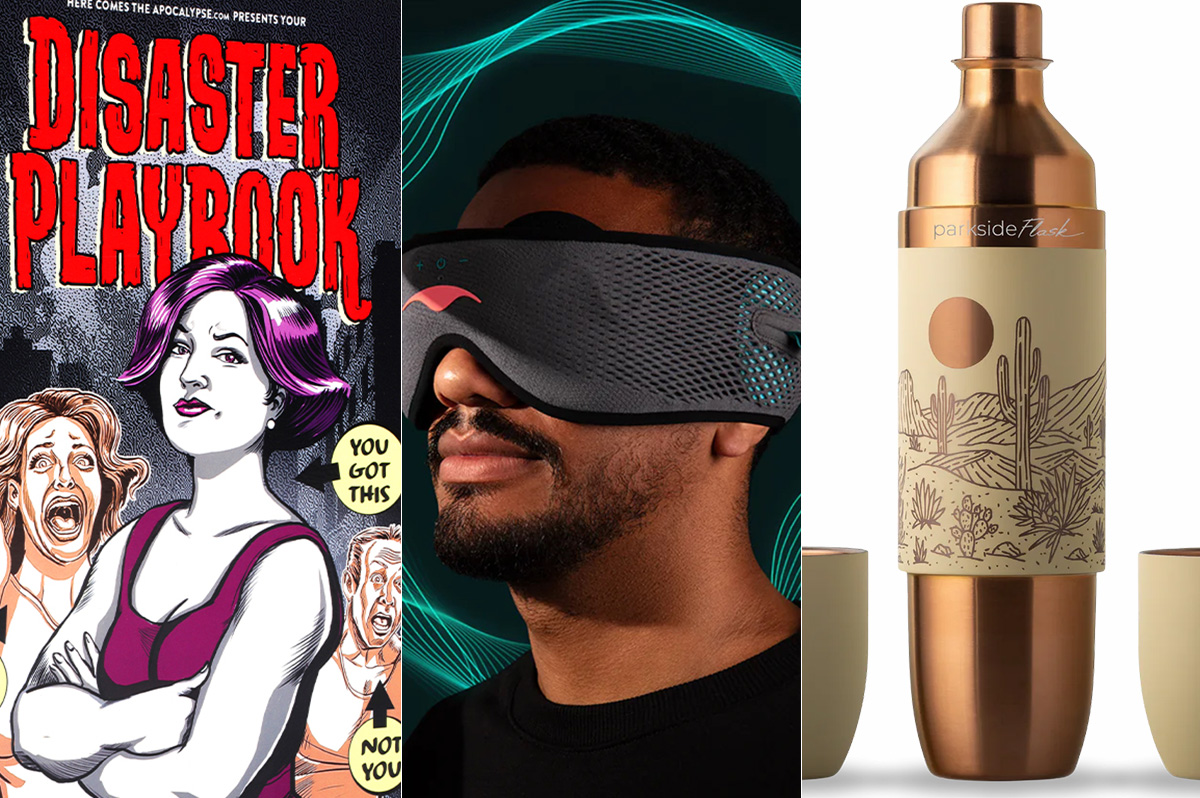
Some gifts scream practical, others whisper luxury, and a few flat-out blur the lines. From cocoa that feels ceremonial to a cologne that linger like a suggestive smirk, this year’s ultimate gift picks prove that thoughtful (and occasionally naughty) presents don’t have to be prosaic. Welcome to your holiday cheat sheet for festive tangibles that get noticed, remembered, and maybe even result in a peck of gratitude planted under the mistletoe. Consensually, of course.
Amber Glass Champagne Flutes
Pop the champs – but make it vintage. These tulip-shaped stunners in amber-tinted glass bring all the Gatsby vibes without the Jazz-age drama. Whether you’re toasting a milestone or celebrating a Tuesday, their seven-ounce capacities and hand-wash-only care make ‘em as practical as they are pretty. Pair with a thoughtful bottle of bubs and gift with a glittering wink. $18, NantucketLooms.com
Disaster Playbook by Here Comes the Apocalypse
Because the end of the world shouldn’t be a solo act, this spiral-bound guide is your step-by-step roadmap to surviving and thriving when everything else goes sideways, which might be sooner than you think. Packed with checklists, drills, and a healthy dose of humor, it’s like a survival manual written by your most prepared (and slightly snarky) friend. Whether you’re prepping for a zombie apocalypse or, more realistically, REVOLUTION!, this playbook’s got your back. $40, HereComesTheApocalypse.com
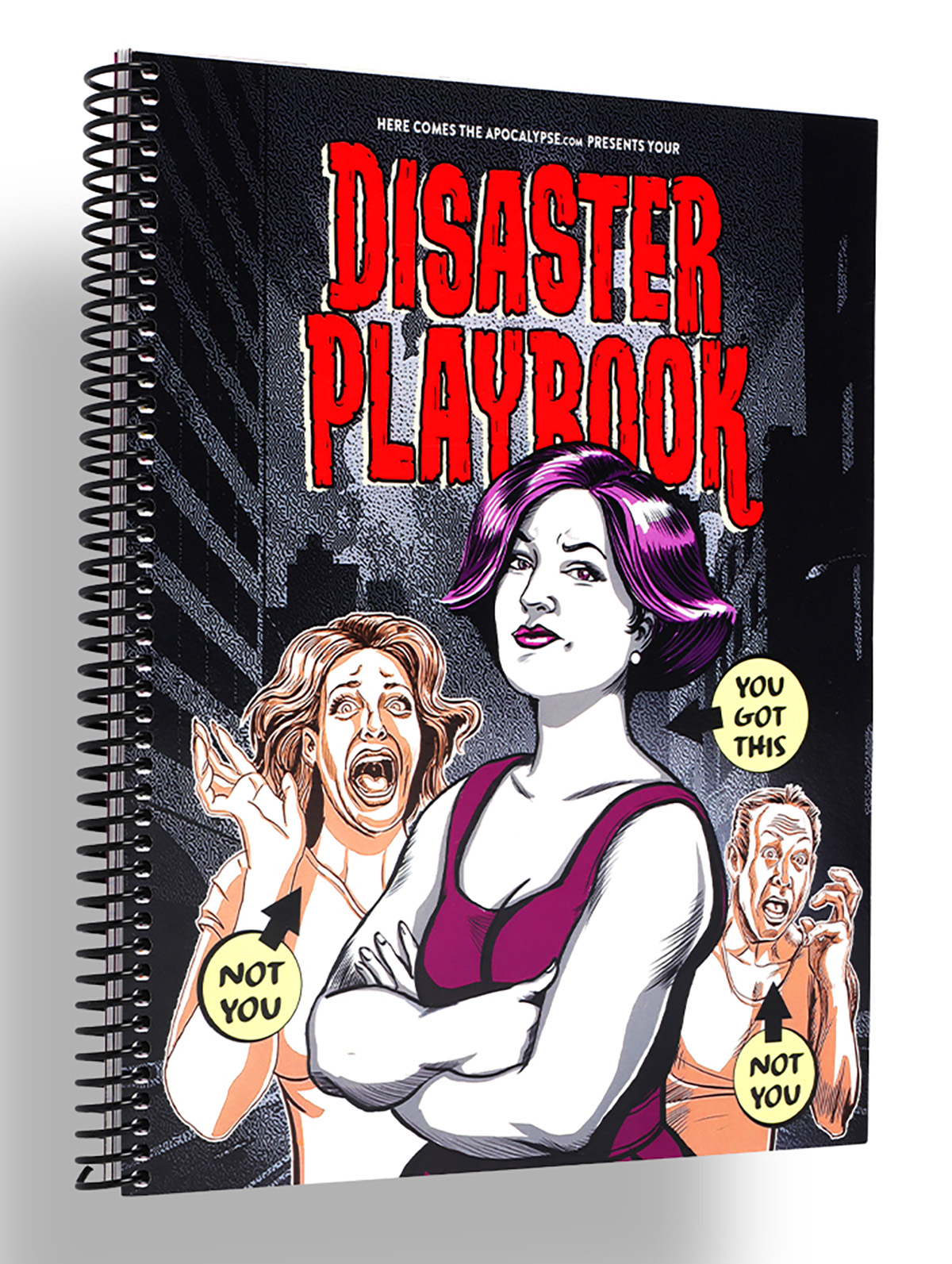
Wickless Vulva Candles
Bold, luxurious, and completely flame-free, CTOAN’s wickless candles melt from beneath on a warmer, releasing subtle, sophisticated fragrances, like sandalwood or lavender. The vulva-shaped wax adds a playful, provocative element to any space –perfect for a bedroom, living room, or anywhere you want elegance with an edge. A gift that celebrates form, intimacy and self-expression, no fire required. $39, CTOANCO.com
Villeroy & Boch Royal Classic Christmas Collection
Every meal is a mini celebration – with whimsy at every place setting – in Villeroy & Boch’s Royal Classic festive dinnerware collection that hits all the right notes. Made from premium German porcelain, it features nostalgic little toys, nutcrackers, and rocking horses in delicate relief, giving your holiday spread a playful but refined twist. Dishwasher- and microwave-safe, it’s luxe without the fuss. Gift a piece to a special someone, or start a collection they’ll use (and show off) for years to come. $22-$363, Villeroy-Boch.com
Greenworks Electric Lawnmower
You a ’hood queen who considers lawn care performance art – or just wants to rule the cul-de-sac in quiet, emission-free glory? Greenworks’ zero-turn electric mower has the muscle of a 24-horsepower gas engine but none of the fumes, drama or maintenance. Six 60V batteries and a 42-inch deck mean you can mow up to two-and-a-half acres on a single charge – then plug in, recharge, and ride again. It’s whisper-quiet, slope-ready, and smooth enough to make you wonder why you ever pushed anything besides your queer agenda. The perfect gift for the homeowner who loves sustainability, symmetry, and showing off their freshly striped yard like that fresh fade you get on Fridays. $5,000, GreenworksTools.com
Molekule Air Purifier
For the friend who treats their space like a sanctuary (or just can’t stand sneezes), the Molekule Air Pro is magic in motion. Covering up to 1,000 square feet, it doesn’t just capture allergens, VOCs, and smoke – it destroys them, leaving your air feeling luxury-clean. FDA-cleared as a Class II medical device, it’s serious science disguised as modern design. Gift it to your city-dwelling, pet-loving, candle-burning friend who likes their living room as pristine as their Instagram feed. $1,015, Molekule.com
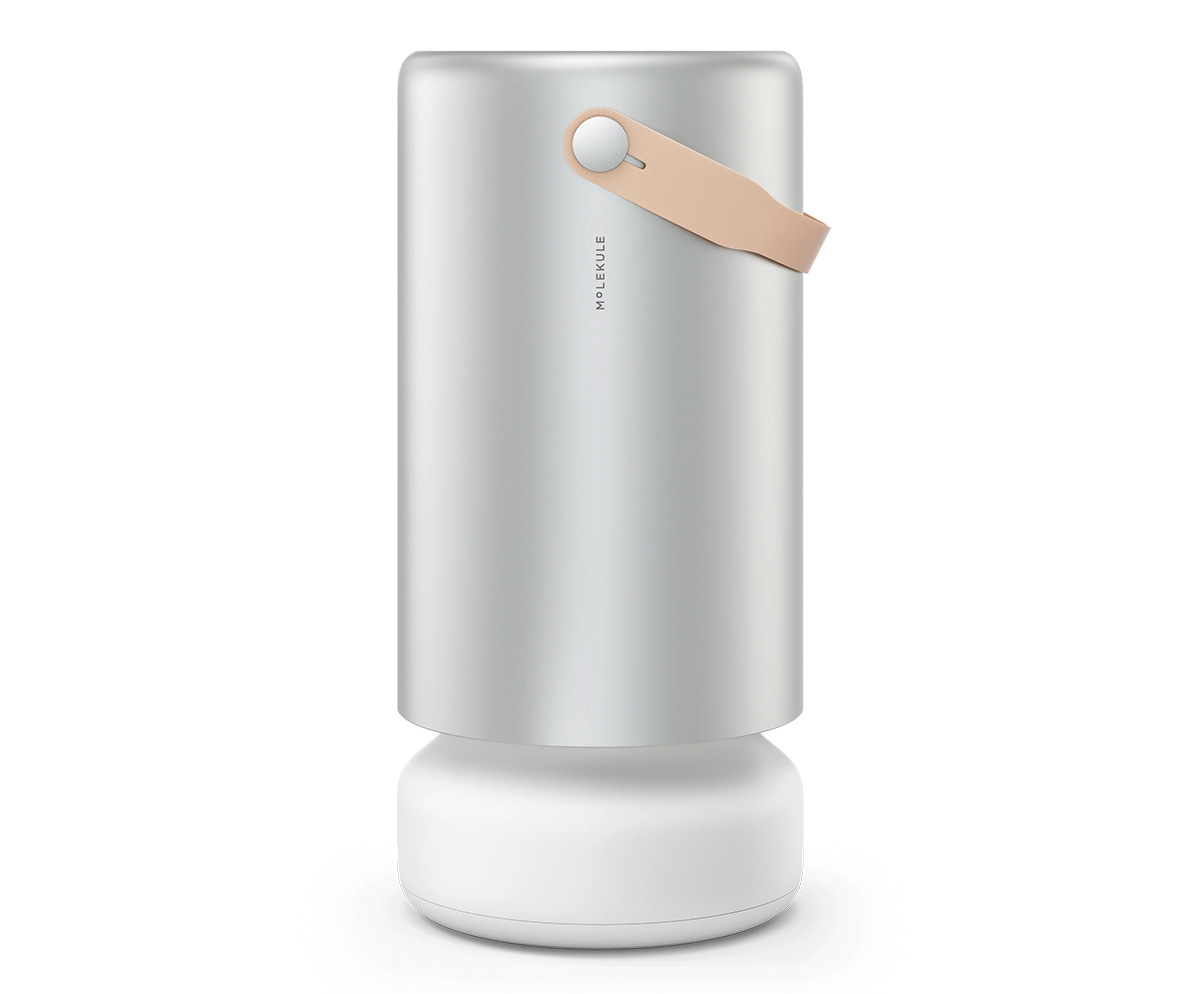
Cipriani Prosecco Gift Set
Effervescent with stone-fruit sweetness and a touch of Italian flair, the Cipriani Bellini & Prosecco gift set brings brunch-level glamour to any day of the week. The Bellini blends rich white-peach purée with sparkling wine, while the dry ’secco keeps things crisp and celebratory. Pop a bottle, pour a flute, and suddenly winter weeknights feel like a party – even with your pants off. $36, TotalWine.com
Woo(e)d Cologne
British GQ recently crowned Woo(e)d by ALTAIA the “Best Date Night Fragrance,” and honestly, they nailed it. Confident without being cocky – smoky gaïac and Atlas cedarwood grounds the room while supple leather and spicy cardamom do all the flirting – it’s a scent that lingers like good conversation and soft candlelight. Gift it to the one who always turns heads – or keep it for yourself and let them come to (and then on) you. $255, BeautyHabit.com
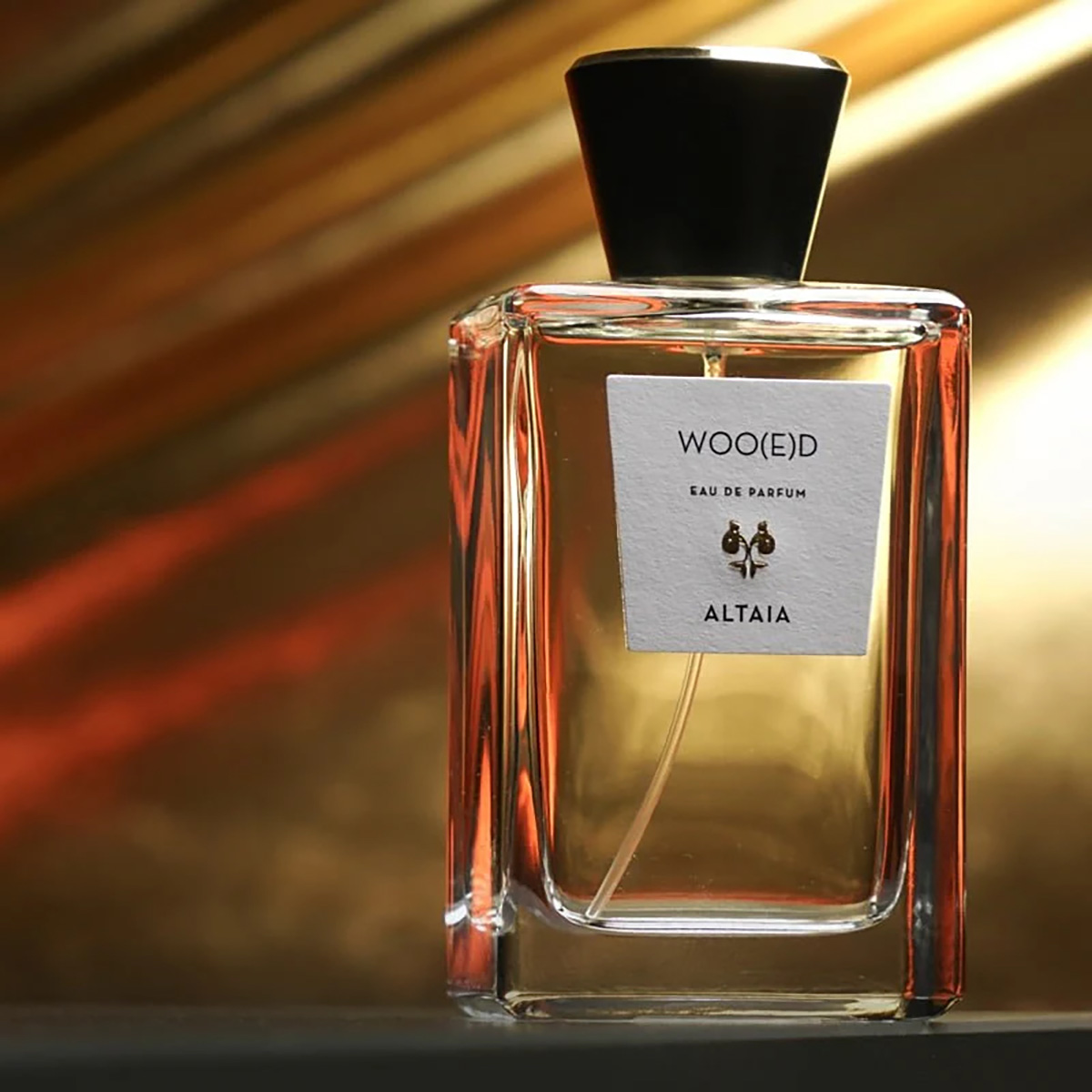
Lococo Cocoa Kit
Keep the run-of-the-mill mugs in the cabinet this Christmas and pull out Lococo’s handcrafted Oaxacan versions that demand you slow down and sip like it matters. Paired with a wooden scoop, rechargeable frother, and Lococo’s signature spice hot-chocolate blend (vegan, gluten-free, with adaptogenic mushrooms), this holiday kit turns Mexi-cocoa into a mini ritual you’ll look forward to. Perfect for anyone who loves a little indulgence with a side of ¡A huevo! energy.
Manta Sleep Mask
Total blackout, zero pressure on the eyes, and Bluetooth speakers built right into the straps, this ain’t your mama’s sleep mask — but it could be. The Manta SOUND sleep mask features C-shaped eye cups that block every hint of light while ultra-thin speakers deliver your favorite white noise, meditation, or late-night playlist straight to your ears. With 24-hour battery life, breathable fabric, and easy-to-adjust sound, it turns any bed (or airplane seat) into a five-star sleep suite. Perfect for anyone who treats shut-eye like an art form (or just wants to escape their roommate’s late-night bingin’ and/or bangin’). $159, MantaSleep.com

Shacklelock Necklace
Turn the industrial-chic vibe of a shackle into a sleek statement. Mi Tesoro’s platinum-plated stainless-steel necklace sits on an 18-inch wheat chain, featuring a shackle-style latch pendant that’s waterproof, tarnish-free, and totally fuss-les. Beyond style, it nods to a classic gesture in the queer leather community: replacing a traditional Master lock with something elegant to quietly signal belonging to someone special. Wear it solo for a minimalist edge or layer it like you mean it; either way this piece locks in both your look and your intentions. $90, MiTesoroJewelry.com
Parkside Flask Mojave Edition
Wine nights get a desert glow-up with Parkside’s limited-edition 750-milliliter all-in-one flask draped in sun-washed bronze and badland hues like sage, sand, and terracotta – with magnetic stemless tumblers that snap on for effortless shareability. It keeps your vino chilled for 24 hours, pours without drips (no tears for spilled rosé, please), and even lets you laser-engrave your own mantra or inside joke. Perfect for picnics, surprise rooftop clinks, or gifting to your favorite wine (or desert) rat. $149, HighCampFlasks.com
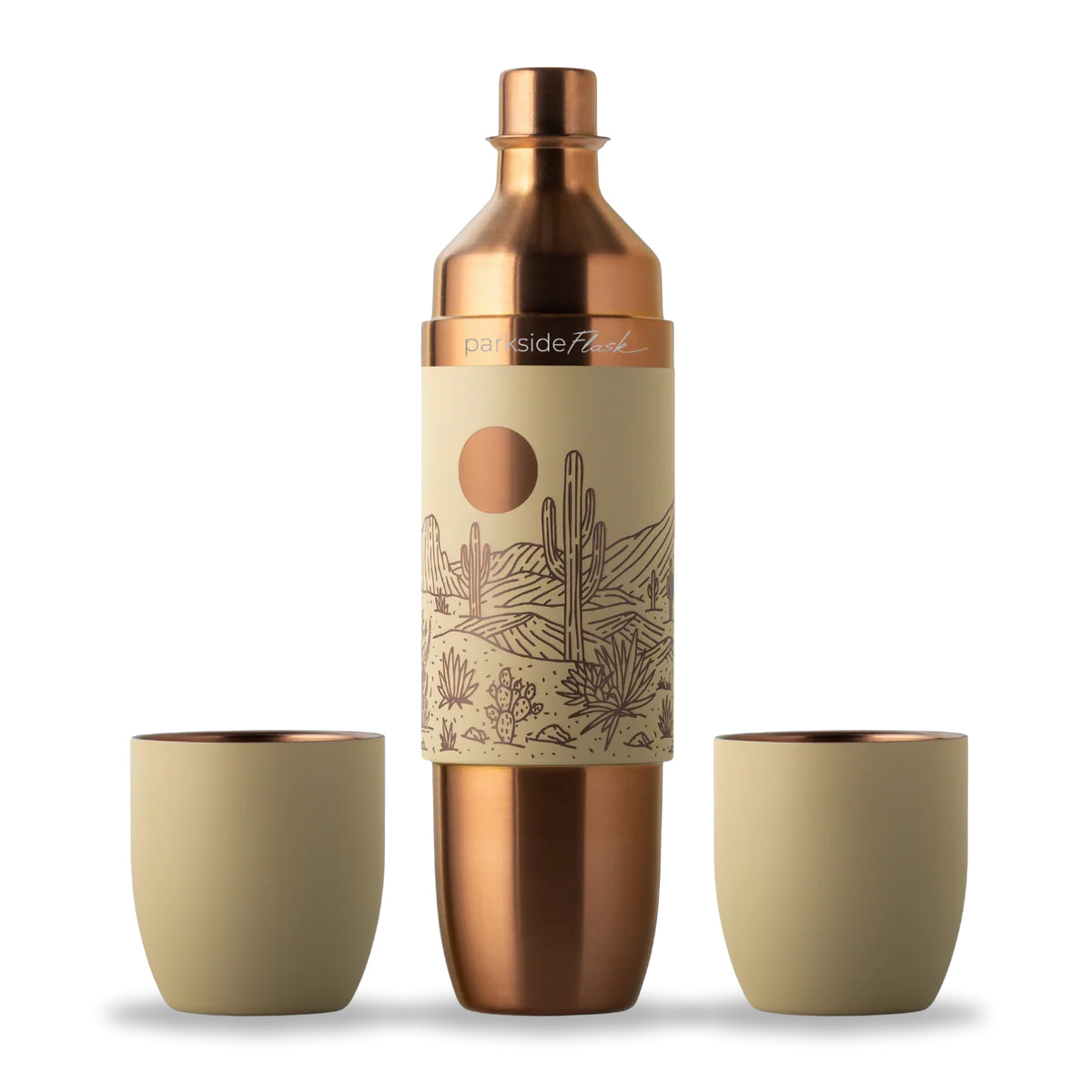
Mikey Rox is an award-winning journalist and LGBT lifestyle expert whose work has published in more than 100 outlets across the world. Connect with him on Instagram @mikeyroxtravels.
a&e features
Meet Mr. Christmas
Hallmark’s Jonathan Bennett on telling gay love stories for mainstream audiences
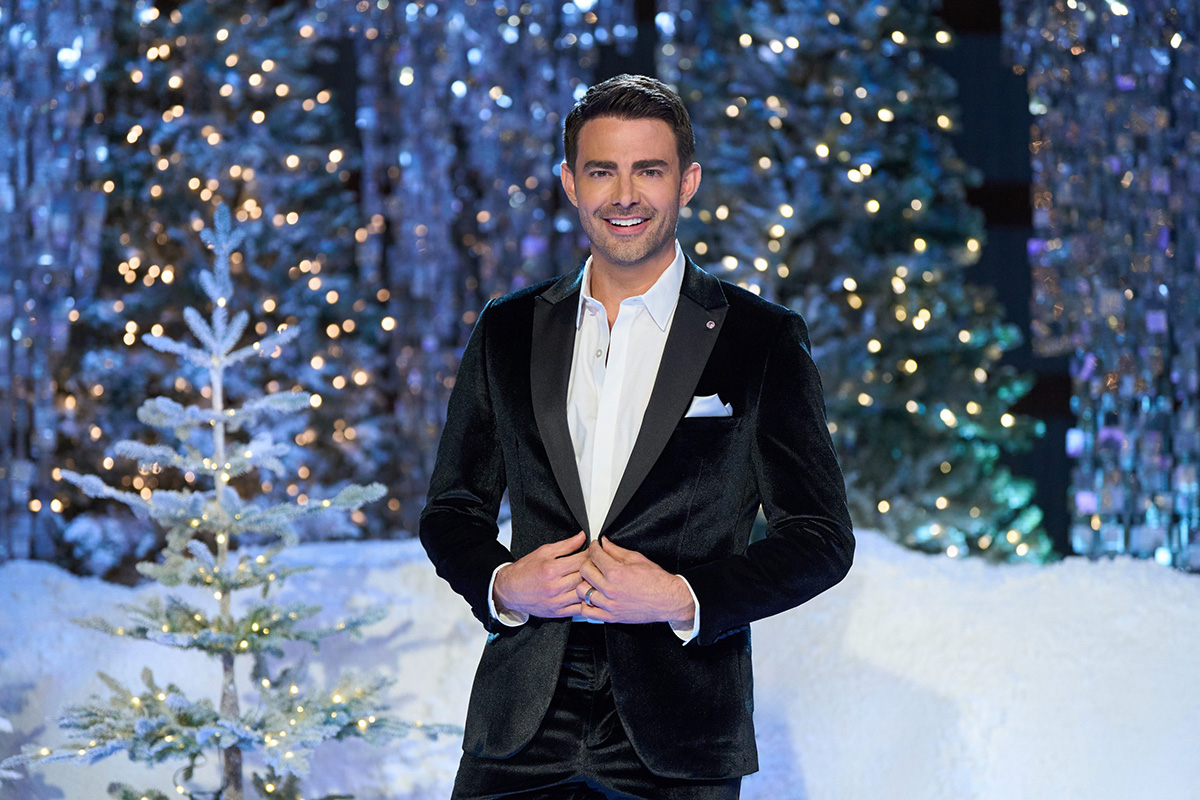
Jonathan Bennett believes there are two kinds of people in the world — those who love Hallmark movies and liars. And in Season 2 of Finding Mr. Christmas, which the Mean Girls star co-created with Ben Roy, Bennett is searching for Hallmark’s next leading man.
“It’s so fun for people because everyone in their life has someone they know that they think should be in Hallmark movies, right? The UPS driver, the barista at the coffee shop, the dentist,” Bennett says. “So we’re testing their acting abilities, we’re testing who they are, but we’re also looking for that star quality — the thing that makes them shine above everyone else. It’s almost something you can’t explain, but we know it when we see it.”
Season 2’s cast includes a former NFL player for the Green Bay Packers, a few actors, and a realtor. The 10 men compete in weekly festive-themed acting challenges, one of which included having to ride a horse and act out a scene with Alison Sweeney. The contestants were chosen from a crop of 360 potential men, and Bennett gives kudos to the show’s Emmy-nominated casting director, Lindsay Liles (The Bachelor, Bachelor in Paradise).
“She has a tough job because she has to find 10 guys that are going to be good reality television, but also have the talent to act, carry a scene, and lead a Hallmark movie eventually,” he says. To be the right fit for a Hallmark leading man, Bennett singles out five key characteristics: you have to be funny, charming, kind, have a sense of humor, and you have to do it all with a big heart.
Of course, Finding Mr. Christmas wouldn’t be Finding Mr. Christmas without its signature eye candy — something Bennett describes as “part of the job” for the contestants. “I can’t believe Hallmark let me get away with this. I dressed them as sexy reindeer and put them in harnesses attached to a cable 30 feet in the air, and they had to do a sexy reindeer photo shoot challenge,” he says with a laugh. “This season is just bigger and bolder than last. People are responding to not only all the craziness that we put them through, but also comparing and contrasting the guys in their acting scenes when we do them back-to-back.”
Season 1 winner Ezra Moreland’s career has been an early testament to the show’s success at finding rising talent. On seeing the show’s first winner flourish, Bennett says, “Now to watch him out in the world, just booking commercial after commercial and shining as an actor and a model, I think the show gave him the wings to do that. He learned so much about himself, and he took all that into his future auditions and casting. He just works nonstop. I’ve never seen an actor book more commercials and modeling gigs in my life.”
Bennett has been a star of plenty of Hallmark movies himself, including the GLAAD-award-winning The Groomsmen: Second Chances, which makes him a fitting host. Among those movies are 2020’s Christmas House, which featured the first same-sex kiss on the network and had a major impact on Bennett’s career as an openly gay man. “Hallmark’s been so great about supporting me in queer storytelling. But again, I don’t make gay movies for gay audiences. I make gay love stories for a broad audience, and that’s a huge difference, right? We’re not telling stories inside baseball that only the gay community will understand.”
He continues, “The backdrop of a Hallmark Christmas movie is very familiar to these people who watch. And so when you tell a gay love story, and you tell it no differently than a straight love story in that space, they’re able to understand. It’s able to change hearts and minds for people who might not have it in their lives.”
While Hallmark has become a major staple of Bennett’s career, he started off wanting to be a Broadway actor. And before the first season of Finding Mr. Christmas aired, Bennett took a break from TV to make his Broadway debut in Spamalot, replacing Michael Urie as Sir Robin and starring alongside Ethan Slater and Alex Brightman.
“That was my dream since I was five years old – then I booked a movie called Mean Girls, and everything kind of changes in your life. You no longer become a person pursuing Broadway, you become a part of pop culture,” Bennett recalls. “And to be honest, when I hit 40, I was like, ‘I’m probably never going to get to live that dream.’ And that’s okay, because I got to do other dreams and other things that were just as cool but different. So I honestly never thought it would happen.”
Bennett is still determined to make his way back on Broadway with the right role — he calls Spamalot the “best experience” of his life, after all — but he’s got another Hallmark show lined up with Murder Mystery House, which he co-created. The show was recently greenlit for development and intends to bring the Hallmark mystery movie to life. “It’s kind of like our version of The Traitors,” Bennett admits.
Looking back on both seasons, Bennett says that what makes Finding Mr. Christmas stand out in the overcrowded reality TV landscape is that everyone involved makes it with heart: “This isn’t a show where you’re going to watch people throw drinks in each other’s faces and get into big fights. The thing that has amazed me so much about this show, the more we’ve done it, is that every season, 10 guys come in as competitors, but they leave as a family and as brothers. That’s something you don’t get on any other network.”
Finding Mr. Christmas airs every Monday on Hallmark through December 20, with episodes available to stream on Hallmark+.

